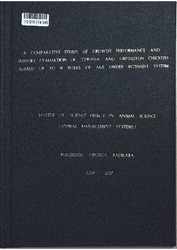| dc.description.abstract | Two studies were carried out to compare growth performance, carcass characteristics and sensory evaluation of local Tswana chickens and Orpingtons. In the first study, a total of 120 day-old chicks (60 Tswana and 60 Orpington) were randomly distributed to four replicates using a completely randomized design. Birds were raised under intensive system up to 18 weeks of age and fed commercial broiler diets. Parameters recorded included feed intake, body weight (BW), body weight gain (BWG), feed conversion ratio (FCR), mortality, final live weight, and dressed weight, dressing percentage and portions /primal cuts weight. Data were analysed using the General Linear Model Procedures in Statistical Analysis System (SAS). There were no significant differences (P>0.05) in feed intake amongst the tested chicken lines. No significant sex differences (P>0.05) in BW between Orpington and Tswana chickens were observed. At 11 and 18 weeks of age BWG of Orpington males were significantly (P<0.05) higher than Tswana chickens males (135.58± 8.00 and 132.74 ± 8.51; 94.39 ± 7.60 and 51.82 ± 8.26, respectively). Males were significantly (P<0.05) heavier than their age-matched female counterparts and FCR of Orpington chickens was lower than that of Tswana chickens. Higher mortality rate was recorded in Tswana chickens (8%) compared to Orpingtons (5%). At 18 weeks of age, higher final live weight was recorded in Orpington (male 1862.74 g; female 1493.46 g) compared to Tswana chickens (male 1732.89 g; female 1467.90 g). Orpington chickens had significantly (P<0.05) higher live weight, dressed weight, carcass weight and primal cuts weight compared to Tswana chickens. No differences (P>0.05) were observed for dressing percentage. These results imply that Orpington chickens may be considered for future breed improvement programmes. In the second study, 40 randomly selected chickens of each genotype (Orpington and Tswana) were sacrificed at 18 weeks of age and their carcasses cut into portions/primal parts and kept in a freezer at -8 °C until analyses were performed. Left breast and thigh portions were used tenderness measurements and the right breast and thigh portions were subjected to sensory evaluation where a 9-point hedonic scale was used to determine overall liking and disliking of juiciness, flavour/aroma and acceptability of meat by naive panelists. Meat samples were boiled separately in unsalted water for 30 minutes (breast) and 25 minutes (thigh) and cut into 1 x 1 x 1 cm cubes before being presented to panelists. Meat tenderness was analysed using General Linear Model (GLM) procedure of the Statistical Analysis System. Data on sensory attributes were analysed using frequencies and percentages in IBM SPSS statistics version 23. However, no significant differences (P>0.05) in breast and thigh meat tenderness of Orpington and Tswana chickens was observed. For overall acceptance, 50% of consumers liked Tswana chicken meat compared to 20.9% for Orpington meat. Although Orpington chicken was juicier than Tswana chicken meat, most of the panelists liked flavour of Tswana chicken meat | en_US |

